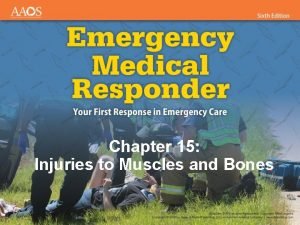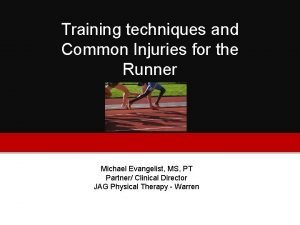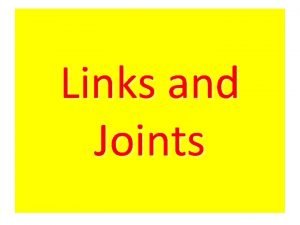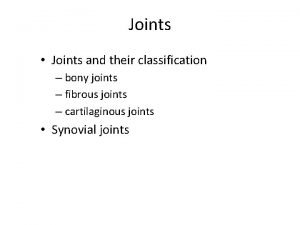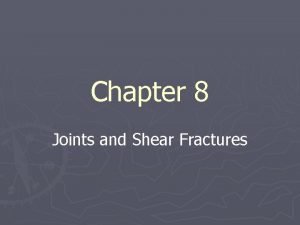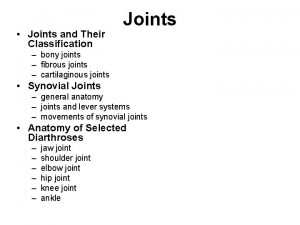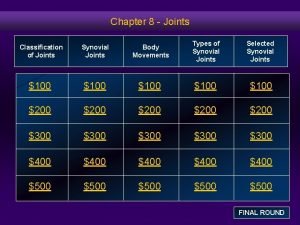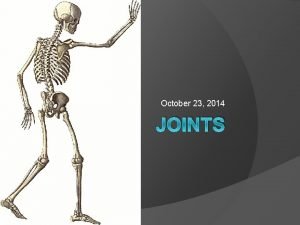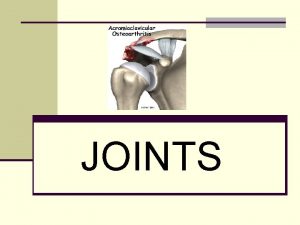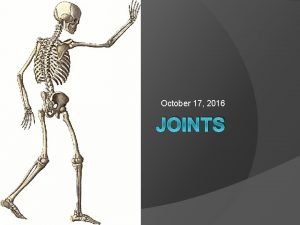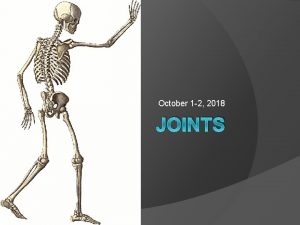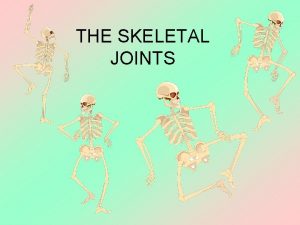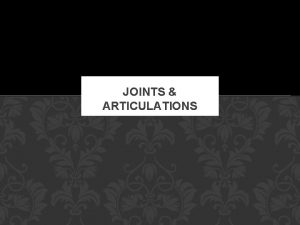Joints Movement and Injuries What are joints Jointsplaces















- Slides: 15

Joints, Movement and Injuries

What are joints? • Joints-places where two bones articulate or come together. • The human body contains three types of joints: – Fibrous – Cartilaginous – Synovial

Fibrous Joints • Found where bones have close contact with each other. • Connective tissue found between the joint • Little to no movement • Ex. Found between the sutures of the skull

Cartilaginous joints • Found where shock absorption occurs. • Hyaline cartilage or fibro-cartilage found between the joint. • Limited movement, twisting and bending. • Found between the vertebrae, sternum to ribs and pubis bone.

Synovial Joints • Most of the joints in the skeletal system are synovial joints which allow free movement. • Includes hyaline cartilage, connective tissue, synovial membrane and fluid and bursa. • Classified into six categories: Ball and Socket, Hinge, Saddle, Condylar (ellipsoid), Pivot and Plane (gliding)

Types of Synovial Joints Based on Shape Figure 5. 29 a–c Copyright © 2003 Pearson Education, Inc. publishing as Benjamin Cummings Slide

Types of Synovial Joints Based on Shape Figure 5. 29 d–f Copyright © 2003 Pearson Education, Inc. publishing as Benjamin Cummings Slide

1. Ball-and-Socket joint • Ball shaped head of one bone connects to cup-shaped cavity of another. • Allows circular motion and motion in all planes. • Hip and shoulder

2. Condylar joint (ellipsoid) • Oval shaped condyle fits into an elliptical cavity of another. • Variety of movements in different planes but not rotational. (twisting) • Metacarpals connection with the phalanges.

3. Plane Joints • Flat and curved surfaces connect. • Allows sliding and gliding motion. • Bones of wrist and ankle.

4. Hinge Joint • Convex surface of one bone connects to concave surface of another. • Movement in one plane. (like a door) • Elbow, knee and phalanges.

5. Pivot joint • Cylindrical surface of one bone rotates within a ring formed of bone and ligament. • Movement around a central axis-rotation. • Atlas (the Greek god who supported the world on his shoulders) and axis in cervical vertebrae. • Radius/ulna and atlas/axis

6. Saddle joint • Connect bones with convex and concave surfaces. • Variety of movements in two planes. • Bones at carpal and metacarpal of thumb.


Disorders of joints § Injuries § Sprains § Dislocations § Torn cartilage § Inflammatory and degenerative conditions § Bursitis § Tendinitis § Arthritis § § Osteoarthritis (“DJD” – degenerative joint disease) Rheumatoid arthritis (one of many “autoimmune” arthritites) Gout (crystal arthropathy) Septic arthritis-bacterial infection
 Mikael ferm
Mikael ferm Movement area
Movement area What are the locomotor and axial movements
What are the locomotor and axial movements Unit 15:10 providing first aid for specific injuries
Unit 15:10 providing first aid for specific injuries A short backboard or vest-style immobilization
A short backboard or vest-style immobilization Chapter 21 caring for head and spine injuries
Chapter 21 caring for head and spine injuries Emr chapter 15 injuries to muscles and bones
Emr chapter 15 injuries to muscles and bones Chapter 14:3 observing fire safety
Chapter 14:3 observing fire safety Chapter 14 bleeding shock and soft tissue injuries
Chapter 14 bleeding shock and soft tissue injuries Chapter 13:2 preventing accidents and injuries
Chapter 13:2 preventing accidents and injuries Chapter 11 assessment and evaluation of sports injuries
Chapter 11 assessment and evaluation of sports injuries Glencoe health chapter 12
Glencoe health chapter 12 Common track injuries
Common track injuries How are sports injuries classified and managed
How are sports injuries classified and managed Tim madsen climber
Tim madsen climber Hunger games chapter 14 questions and answers
Hunger games chapter 14 questions and answers






